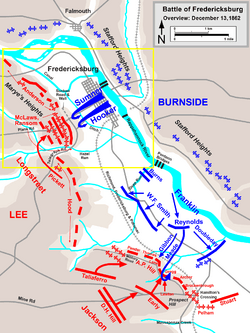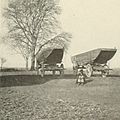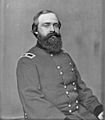Battle of Fredericksburg facts for kids
Quick facts for kids Battle of Fredericksburg |
|||||||
|---|---|---|---|---|---|---|---|
| Part of the American Civil War | |||||||
 Battle of Fredericksburg: the Army of the Potomac crossing the Rappahannock River in the morning of December 13, 1862, by Kurz and Allison (1888) |
|||||||
|
|||||||
| Belligerents | |||||||
| Commanders and leaders | |||||||
| Units involved | |||||||
| Army of the Potomac | Army of Northern Virginia | ||||||
| Strength | |||||||
|
122,009 |
78,513 |
||||||
| Casualties and losses | |||||||
| 12,653
1,284 killed
9,600 wounded 1,769 captured/missing |
5,377
608 killed
4,116 wounded 653 captured/missing |
||||||
The Battle of Fredericksburg was a huge fight during the American Civil War. It happened from December 11 to 15, 1862, in Fredericksburg, Virginia. Nearly 200,000 soldiers took part, making it one of the biggest battles of the war. It was also the first time in U.S. history that a large army had to cross a river while the enemy was actively fighting them.
Contents
Why the Battle Happened
After the Battle of Antietam, General Robert E. Lee and his Confederate army went back to Virginia. The Union General George B. McClellan didn't follow them closely. President Abraham Lincoln wanted McClellan to attack the Confederates. But McClellan kept saying he didn't have enough soldiers or supplies.
Finally, in November 1862, Lincoln replaced McClellan. He put General Ambrose Burnside in charge of the Union's Army of the Potomac. Burnside didn't really want the job.
Burnside's new plan was to move his army towards Richmond, Virginia, which was the Confederate capital. He decided to go through Fredericksburg. This way, the Union Navy could bring him supplies by river. This would be safer than moving supplies over land.
The Battle Begins
Crossing the River
Burnside planned to cross the Rappahannock River at Fredericksburg using special pontoon bridges. But these bridges arrived two weeks late. This delay gave General Lee plenty of time to gather his Confederate forces. The Union army lost its chance to surprise the enemy.
On December 11, Union soldiers started building the pontoon bridges. Confederate soldiers fired at them, slowing them down. Union cannons fired back from Stafford Heights, damaging the town. But the Confederates didn't leave.
Finally, the bridges were finished that evening. More than 120,000 Union troops crossed into Fredericksburg. Lee's army fought just enough to give General Stonewall Jackson's troops time to get into position. The Confederate line stretched for about three miles.
Waiting and Looting
On December 12, the morning was foggy. Burnside sent more troops into the town. But he didn't organize an attack. Instead, his soldiers spent the day looting and damaging houses and shops. This wasted valuable time.
The Main Attack: December 13
Burnside finally gave his attack orders on December 13. He told General William B. Franklin to attack Jackson's troops. Then, General Edwin Vose Sumner was to attack a strong Confederate position called Marye's Heights.
However, Burnside's orders were not very clear. Franklin was told to attack with "a division at least." He sent only one division, led by General George G. Meade, with 4,500 men. They marched towards Jackson's line.
Two small Confederate cannons fired at Meade's advancing troops. Even though he was told to stop, Major John Pelham kept firing for over an hour. When he ran out of ammunition, he pulled his cannons back.
Meade's division kept moving. When they were about 500 yards away, Jackson's hidden 14 cannons opened fire. Many Union soldiers were cut down. An artillery battle began and lasted for an hour.
Meade's troops found a 600-yard gap in Jackson's line in the woods. They pushed into it. A South Carolina brigade at first thought Meade's troops were retreating Confederates. So they didn't fire. This allowed the Union soldiers to get deep into Jackson's line. But Jackson quickly ordered a counterattack. He drove the Union troops back to their own lines.
Meanwhile, Burnside was waiting at his headquarters. He expected to hear that Meade had pushed Jackson back. When no news came, he ordered the attack on Marye's Heights to go ahead anyway.
Cannons on Marye's Heights and nearby hills made it almost impossible to attack the Heights. But Sumner ordered many attacks all afternoon. Confederate artillery rained shells down on the Union soldiers.
One after another, three Union divisions tried to climb Marye's Heights. All of them failed. Nearly 3,000 men were lost in just one hour. But the attacks kept going with no success.
General Lee watched the Union soldiers being destroyed. He famously said, "It is well that war is so terrible. We should grow too fond of it."
Out of 12,600 Union soldiers who were killed, wounded, or missing, almost two-thirds were lost attacking Marye's Heights. The Confederates lost about 5,000 men in the battle.
What Happened After
Even though Lee won a big victory, he lost soldiers and equipment that were hard to replace. Burnside's losses were huge, but the Union could replace their soldiers more easily.
The Battle of Fredericksburg was very bad news for the North. But it didn't change the overall course of the war much. It did, however, make the Confederates feel much better about their chances.
In January 1863, Burnside was replaced as the commander of the Army of the Potomac. General Joseph Hooker took his place. But Hooker would also be replaced after another terrible battle, the Battle of Chancellorsville.
Interesting Facts About the Battle of Fredericksburg

- This was the first time in the Civil War that fighting happened right in the streets and houses of a town.
- After the battle, many buildings were destroyed. Union soldiers then looted the town.
- The Union generals didn't talk to each other very well. Also, the special pontoon bridges arrived late. This gave the Confederates lots of time to get more soldiers ready.
- The Confederates had 4,201 soldiers killed, wounded, or missing. The Union had 12,653.
- Some history books say it was freezing during the battle. But it wasn't that cold; it was about 56 degrees Fahrenheit (13.3 degrees Celsius).
- More soldiers fought in this battle than almost any other in the Civil War.
Images for kids
-
The sunken road at Marye's Heights in 2010. Approximately 3,000 Georgians under Thomas R. R. Cobb were lined up in multiple ranks behind the stone wall, and another 3,000 were atop the slope behind it, along with their artillery.
-
Maj. Gen. Ambrose Burnside, (Commanding) -
Maj. Gen. Edwin V. Sumner, Right Grand Division -
Maj. Gen. Joseph Hooker, Center Grand Division -
Maj. Gen. William B. Franklin, Left Grand Division -
Gen. Robert E. Lee, (Commanding) -
Lt. Gen. James Longstreet, First Corps -
Lt. Gen. Stonewall Jackson, Second Corps -
Maj. Gen. J.E.B. Stuart, Cav. Div. -
Sumner's headquarters, Chatham Manor, on Stafford Heights; Burnside observed the battle primarily from this location
-
Brig. Gen. John Gibbon, wounded -
Brig. Gen. Nathan Kimball, wounded -
Brig. Gen. John C. Caldwell, wounded -
Brig. Gen. Maxcy Gregg, mortally wounded -
Brig. Gen. Thomas R. R. Cobb, mortally wounded
See also
 In Spanish: Batalla de Fredericksburg para niños
In Spanish: Batalla de Fredericksburg para niños




































